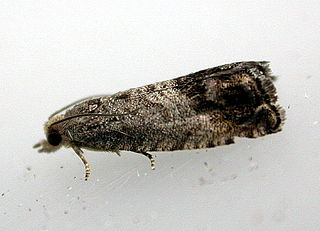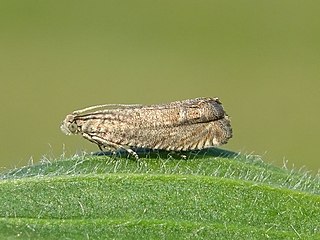
The Tortricidae are a family of moths, commonly known as tortrix moths or leafroller moths, in the order Lepidoptera. This large family has over 11,000 species described, and is the sole member of the superfamily Tortricoidea, although the genus Heliocosma is sometimes placed within this superfamily. Many of these are economically important pests. Olethreutidae is a junior synonym. The typical resting posture is with the wings folded back, producing a rather rounded profile.

The codling moth is a member of the Lepidopteran family Tortricidae. They are major pests to agricultural crops, mainly fruits such as apples and pears, and a codling moth larva is often called an "apple worm". Because the larvae are not able to feed on leaves, they are highly dependent on fruits as a food source and thus have a significant impact on crops. The caterpillars bore into fruit and stop it from growing, which leads to premature ripening. Various means of control, including chemical, biological, and preventive, have been implemented. This moth has a widespread distribution, being found on six continents. Adaptive behavior such as diapause and multiple generations per breeding season have allowed this moth to persist even during years of bad climatic conditions.

Cydia is a large genus of tortrix moths, belonging to the tribe Grapholitini of subfamily Olethreutinae. Its distinctness from and delimitation versus the tribe's type genus Grapholita requires further study.

Cydia succedana, or Gorse Pod Moth is a species of moth of the family Tortricidae. It is found in Europe and has been introduced to New Zealand.

Cydia splendana, the chestnut tortrix, is a moth of the family Tortricidae. It is found in Europe. It is also known as the acorn moth, but this can also refer to Blastobasis glandulella from North America, which belongs to the more primitive family Blastobasidae.

Cydia is a graphical user interface of APT for iOS. It enables a user to find and install software not authorized by Apple on jailbroken iPhones, iPads and iPod Touch devices. It also refers to the digital distribution platform for software on iOS accessed through Cydia software. Most of the software packages available through Cydia are free of charge, although some require purchasing.

Cydia fagiglandana, the beech moth, is a moth of the family Tortricidae.

Cydia pactolana, the spruce bark tortrix, is a moth of the family Tortricidae. It is found in central, northern and eastern Europe as well as Siberia. In Japan, the subspecies Cydia pactolana yasudai is present.

Cydia amplana, the rusty oak moth, is a moth of the family Tortricidae. It is found from northern, central and southern Europe to Asia Minor, south-western Russia and Transcaucasus.

Cydia duplicana is a small moth of the family Tortricidae. It is found in all across Europe, extending barely into Asia in the Transcaucasus, Turkestan and Kazakhstan.

Cydia illutana is a small moth of the family Tortricidae. It is found from western and central Europe, north to Scandinavia and east to Russia (Siberia).

Jay Ryan Freeman is an American businessman and software engineer. He is known for creating the Cydia software application and related software for jailbroken iOS—a modified version of Apple's iOS that allows for the installation and customization of software outside of the regulation imposed by the App Store system.
Cydia crassicornis is a moth of the family Tortricidae. It was first described by Lord Walsingham in 1907. It is endemic to the island of Hawaii.
Sideloading describes the process of transferring files between two local devices, in particular between a personal computer and a mobile device such as a mobile phone, smartphone, PDA, tablet, portable media player or e-reader.

Cydia inquinatana is a species of moth of the family Tortricidae. It is found in most of Europe, except Ireland, the Iberian Peninsula and the southern part of the Balkan Peninsula. It has recently turned up in the southeast of Great Britain where it may be breeding.
Cydia cognatana is a species of moth belonging to the family Tortricidae. The species was first described by Charles Golding Barrett in 1874.

Cydia coniferana is a Palearctic moth belonging to the family Tortricidae. The species was first described by Saxesen in 1840. The wingspan is 11–13 mm. The forewings are dark fuscous, the costa posteriorly with white strigulae, some ending in obscure leaden-metallic marks. There is an irregular erect white dorsal median spot, including a dark fuscous strigula. The ocellus is edged with leaden-metallic, and crossed by several black dashes. The hindwings are fuscous. The larva is dull yellowish ; head pale brown

Cydia microgrammana is a moth belonging to the family Tortricidae. The species was first described by Achille Guenée in 1845.

Cydia conicolana is a species of moth belonging to the family Tortricidae.















